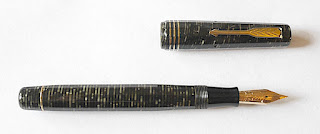A Tale of Several Lizards
Too often I get to the end of a particularly challenging or
satisfying restoration effort and find myself saying “gosh darn (well not
exactly) I should have recorded that.”
Well, this time I was doing the work for a friend and she reminded
me. So here goes.
The story begins at the recent Washington DC Supershow. It
is one of the two biggest in the universe and that made this whole enterprise
possible since I was able to put the pieces together on the spot rather than
having to chase all over the internet and pray that it would all come together.
It helped that I was dealing with friends.
The pen under consideration is pretty uncommon. Any Pelikan
lizard is to be valued, but the short captop models are even less common. As
you can see here it came to me in pretty sad shape.
The binde
was pretty much shot and the barrel broken in two and held together with tape.
It was a cap. Fortunately that was in relatively good condition with only a
hairline caplip crack along a lamination, pretty common in these pens and
easily and safely sealed.
Even before purchasing the cap I was able to source a barrel
that was a good match both in terms of fit and pattern. It was a bit rough
cosmetically, as you can see, but that could be dealt with.
At this point I had
all the pieces I needed. I had only to get home to my workshop and parts bins.
Once I got home the restoration was pretty straightforward.
I did want to save the old lizard binde, I had plans for that.
The new barrel and binde were clean and were slip-fitted
together.
So it was only a matter of finding the right parts. The
Pelikan 100 and 100N models post high and so a proper fit between the filling
mechanism and the cap is essential. Also, the captop and barrel were from about
1938, so I wanted a hard rubber mechanism, and one without wear, since I wanted
it to be a 9/10 restoration. Also critical was getting a good fit between the
mechanism and the barrel, one that yould not stress the delicate thread end of
the barrel. It took a good solid half hour of pulling and fitting parts to get
the right match.
From there it was only a matter of fitting parts together,
to be honest. I needed a new cork for the seal. I needed to install the nib and
then to carefully polish the pen.
This tale has a particularly amusing finish. I had not
initially thought of this as a pen for myself. I’m not sure why, but I didn’t,
despite the fact that I have the other three lizard variants (though all in
yellow gold finish. They do come in white metal too.) It was for a friend at
the show. The next day, on Sunday, another of these rare pens showed up and I
snagged that, too. But, again, not for myself. Only after restoring pen A and
cleaning up pen B (which was intact, restored but not in as good condition) did
the penny drop. I needed to keep one.
Finally, this little case came to me as well, in the course
of the show. All lizardy goodness!!
It would be false modesty to say this work is easy. It takes
some degree of knowledge and dexterity. Having lots of parts and patience helps.
But in this case, the end justifies the work.
























Comments
The pens look amazing. Taking the broken parts and making such a beautiful restoration is a piece of art. Shall we call you Doctor, the patient survived I can't wait to see them in person.
Phillip Moss